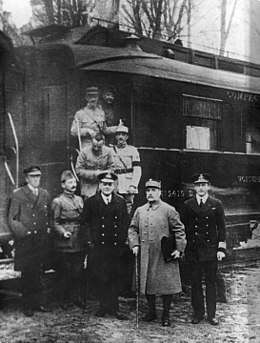Compiègne Wagon
The Compiègne Wagon was the train carriage in which both the Armistice of 11 November 1918 and Armistice of 22 June 1940 were signed.


Before the 1918 signing in the Forest of Compiègne, the wagon served as the personal carriage of Ferdinand Foch and was later displayed in French museums. However, after the successful invasion of France, Adolf Hitler had the wagon moved back to the exact site of the 1918 signing for the 1940 signing due to its symbolic role. The wagon was later destroyed near the end of World War II, most likely by the SS.
History
The Compiègne Wagon was built in 1914 in Saint-Denis as dining car No. 2419D. It was used throughout the First World War in that capacity for Compagnie Internationale des Wagons-Lits, the company best known for operating the Orient Express.[2] In August 1918, the wagon was commandeered by the French Army and converted into the office and mobile headquarters of Ferdinand Foch, the Supreme Allied Commander, who began using it in October 1918.[2][3]
On 8 November 1918, Foch and representatives from the Allied Powers and the German Empire signed the armistice in the then-called "Wagon of Compiègne". This agreement was the final ceasefire which ended fighting in the First World War; the other Central Powers had already reached agreements with the Allied Powers to end hostilities.
The car was later returned to Compagnie Internationale des Wagons-Lits and briefly resumed service as a dining car. In September 1919, it was donated to the Musée de l'Armée, in Paris. The wagon was on display in the Musée's Cour des Invalides from 1921 to 1927.
At the request of the Mayor of Compiègne, and with the support of the American Arthur Henry Fleming, the car was restored and returned to Compiègne. It was housed in a specially created museum building as part of the "Glade of the Armistice" historic monument, with the car a few meters from the exact site of the signing ceremony
During World War II, Hitler ordered that the wagon be moved to exactly the same location for the signing of the second "armistice at Compiègne", on 22 June 1940; this time with Germany victorious. The carriage was moved out of its protective building and returned to the signing-place, which was several metres away and had been marked out as part of the monument. Subsequently, the wagon was taken to Berlin and displayed a week later at the Berlin Cathedral. In 1944 the wagon was sent to Thuringia, in central Germany. Then it moved to Ruhla and later Gotha Crawinkel, near a huge tunnel system. There it was destroyed in March 1945 by the SS with fire and/or dynamite, in the face of the advancing U.S. Army. However, some SS veterans and civilian eyewitnesses claim that the wagon had been destroyed by air attack near Ohrdruf while still in Thuringia in April 1944. Even so, it is generally believed the wagon was destroyed in 1945 by the SS.[4]
Replica
Today's historical wagon is an exact copy of the original one. In 1950, French manufacturer Wagons-Lits, the company that ran the Orient Express, donated a car from the same series to the museum — 2439D is identical to its ravaged twin, from its polished wooden finishes to its studded, leather-bound chairs. This car had also been part of Foch's private train during the 1918 signing. At the 1950 ceremony, it was renumbered No. 2419D. It is parked beside the display of the original car's remains: a few fragments of bronze decoration and two access ramps.[5]
Notes
| Wikimedia Commons has media related to Wagon de l'Armistice. |
- "Clairière de l'Armistice" (in French). Ville de Compiègne. Archived from the original on 27 August 2007.
- "This former dining car where the First and Second Armistices were signed 22 years apart". History TV. Retrieved 2019-12-28.
- Lehrer, Steven. "Compiègne". Retrieved 7 December 2013.
- "The Armistice Carriage". The Armistice Museum (in French). Retrieved 2020-01-18.
- AP news: Hitler in war, Merkel in peace: A train car for history Retrieved 2018-11-10